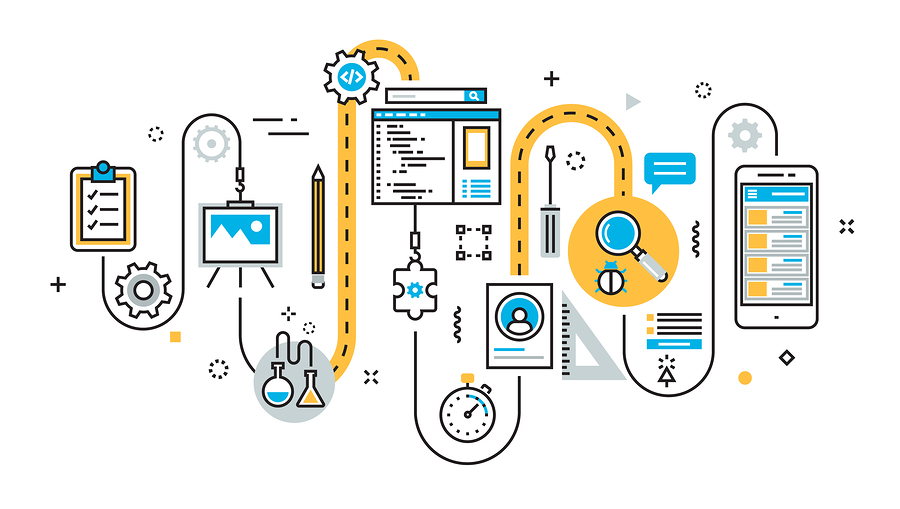8 Ways The Right Mobile App Can Boost Lead Generation
Every organization needs to boost lead generation to remain profitable in the long run. If you’re finding that your business has trouble attracting prospects, you’re likely seeking solutions right now. While there’s no silver bullet for this problem, effective solutions do actually exist.
Regardless of the nature and size of your organization and industry, you can increase lead generation with the right mobile app. Your sales team requires tools to make them effective at finding new leads and gradually driving them down the sales funnel. While there’s no shortage of turnkey solutions that do this, your business can benefit by building a custom mobile app solution.
A custom mobile app will free your sales staff from their desks and allow them to operate without feeling confined by the workflows imposed by the big-name lead generation apps. Here are eight ways that the right mobile app can change the game.
USE OUR APP COST CALCULATOR TO ESTIMATE THE COST TO BUILD YOUR APP!
1. Build A Lead Management App For Your Sales Reps
If you have sales reps operating out in the field, it can become prohibitively expensive for them to chase after unqualified leads. Instead, you want them to be closing deals quickly and cost-effectively. But this is only possible if your sales reps can effectively qualify, segment, and nurture leads. Moreover, you want them to score and track every stage of the lead generation process.
A great solution is to build a lead management app to empower your sales staff. But what does such an app entail, and how will it boost lead generation? One of its most powerful features is its ability to tap into your existing customer database. Mainly because your database already contains a plethora of customer data that reveals who your cold, warm, and hot leads are.
The lead management app will let sales staff filter the most qualified leads. Now, staff won’t have to take any wild guesses on which leads to focus on. By removing the guesswork, your staff will inevitably save time while decreasing travel costs. Furthermore, the lead management app will contain the contact details of prospects who have expressed interest in your brand, products, and services.
Sales staff may further drill down on this data based on customer demographics, geographic locations, and purchasing habits. Also, they can use the lead management app to close, track, and cancel appointments. You can also view this data in real-time and access detailed reports to help you best allocate performance bonuses and pinpoint sales strategies to improve.
2. Boost Lead Generation With An AI-Powered App
Your business may already use customer relationship management (CRM) tools. You could even be using one of the popular cloud-based solutions like Oracle NetSuite CRM, Salesforce, and Zoho CRM. And while these turnkey solutions are great, your staff may experience workflow issues.
No matter how good off-the-shelf solutions have become, they seldom fit every organization perfectly. That’s because some solutions suit mid-sized and larger enterprises since these have more rigid structures. If you have a smaller sales team or have specific needs and workflows, it’s wise to go with a custom solution. And even if you’re using an off-the-shelf CRM, you can integrate it with your custom lead generation app.
But how can you improve workflows on top of what popular solutions offer? Start by surveying your sales staff to determine what pain points they currently experience. To make this process easier, work with an experienced studio like NS804. We’ll draw up wireframes to map out the entire user experience (UX) so that your team will have a point of reference.
But don’t stop there since we can radically improve your new lead generation app with artificial intelligence (AI). While AI is big news lately due to the popularization of tools like ChatGPT, AI is hardly novel. In the mobile space, AI-powered apps have enjoyed popularity for almost a decade. Yet, only recently are companies embracing AI for their mission-critical apps and software infrastructure.
Your sales staff can boost lead generation by running powerful sales campaigns created almost entirely by AI. AI can help staff build marketing funnels, assist with neglected or cold leads, and accurately segment your target customers. And since your AI-powered app will save staff so much time, they can focus on prospecting leads and closing deals.
3. Power Up Your Email Marketing Campaigns
Even if your sales staff regularly conduct face-to-face meetings with customers, they probably use email for their marketing campaigns. After all, email remains a powerful channel for connecting with customers, even with the wide use of social media nowadays. The primary reason is that users retain their email addresses for long durations.
Also, it’s common for users to quit social media due to physical or mental health issues. Some users neglect their accounts, reduce engagement, or flock to the latest trending social media platform. While your sales staff should never ignore social media, they can’t ignore email since it’s a more sustainable and direct channel. The best part is that email can radically boost lead generation if combined with a custom app.
This app will assist your sales staff to automate, personalize, and schedule all email campaigns. Then, you can seamlessly integrate your custom app with your favorite email clients and marketing platforms. Sales staff can effortlessly run campaigns from their smartphones while in any location or time zone. They can also collaborate with your office-bound and remote teams and share progress reports of all campaigns.
But this is only basic functionality that’s enough to help your team get started. You can add additional features later to make your app an all-encompassing solution for your email campaigns.
For example, you can add templates that allow sales staff to create impactful landing pages without the assistance of a designer. An additional A/B testing component will let your team fine-tune their split testing efforts. And with a live chat implementation, your team can communicate directly with leads to drive them down the sales funnel.
4. Enhance Sales Proposal And Contract Agreement Procedures
Your top sales representative probably dislikes writing sales proposals and contracts. But you can reduce the paperwork and drudgery with the right mobile app. Nowadays, there’s little need for your sales reps to spend considerable time writing sales proposals and traveling across the country to have contracts signed.
Instead, they can use templates that contain the company letterhead for proposals and contract agreements. Better yet, these documents can accept electronic signatures, meaning that clients can sign these directly on their mobile devices or PCs. This paperless approach is more environmentally sustainable and makes it easy to keep track of all documentation.
Another benefit of this approach is that documents get to customers fast. This is crucial because leads often go cold if they wait too long for a proposal or contract. If your sales staff doesn’t get this documentation through quickly, customers may have second thoughts about doing business with you. Worse still, a rival may approach them during that time and offer a better deal.
Your custom app can keep track of all outgoing and incoming documentation and issue alerts when customers view or sign these. The app must also have an auto-reminder feature to nudge customers to take action if they haven’t looked at or signed the documentation.
5. Use Mobile Surveys To Boost Lead Generation
Whether you’re targeting regular consumers or business-to-business (B2B) clients, you should survey them regularly. Not only will you gain plenty of valuable customer data, but surveys offer an opportunity to engage leads and drive them towards your brand.
Of course, not everyone enjoys completing surveys, so you’ll need to get creative. Ideally, create a fun and engaging app that your target audience will find appealing.
If you’re targeting a younger audience, add quizzes and gamification features that remind them of their favorite video games. But if you’re targeting business professionals, ensure that your surveys offer fascinating tidbits and practical advice about the industry once they complete specific milestones.
You may also include polls to identify what interests your target audience the most. Furthermore, keep track of all these polls for longer-than-usual durations to determine changing trends. The more interactive your mobile surveys, the easier it becomes to boost lead generation due to greater user engagement and exposure to your brand via your mobile app.
6. Centralize All Contact Details
Keeping all the contact details of leads and customers in one place is challenging. The reason is that most organizations record customer contact details using several platforms like CRMs, databases, and email clients. Sales staff may note down contact details on Post-it notes or their smartphones. Under such circumstances, it’s easy to lose contact details and have duplicate entries.
Therefore, it’s essential to have a central hub to keep an updated record of all contact details. A good solution is to build a mobile app that pulls all contact details across all communication channels within your organization. Sales staff should be able to review and update contact details directly on their mobile devices. They should also segment, filter, and list the customers and leads more likely to make a purchase.
The app should also alert sales staff about customers or leads they haven’t contacted in a long time. Once a sales representative contacts a lead, the app must alert the other sales staff members so they don’t inundate and annoy the same lead with phone calls or emails. The primary goal of your app is to centralize and streamline contact management.
7. Add A Scanning Capability In Your App
Conferences and trade shows are often the best places to meet B2B leads. Visitors at these events usually carry business cards, conference badges, or other identifiers. If you regularly visit these events, you’ve probably become accustomed to collecting and giving away business cards.
But you can simplify the process by scanning another visitor’s card. Your lead generation app will retain a copy of the scan and extract the text and contact details to store in your address book or contact management app. The scanning capability will prove a time saver if you usually collect business cards en masse.
However, the app’s most powerful feature is its ability to disseminate these new contact details among your sales staff. Then, they can follow up with warm and hot leads within minutes if necessary. Or if you’ve placed specific instructions, sales staff will email prospects later about the products, services, or topics you’ve already discussed with them at the event.
The ability for your sales staff to create personalized emails based on your face-to-face interactions with prospects will help boost lead generation. Moreover, there’s a higher likelihood to win them over and drive them down the sales funnel rapidly.
SCHEDULE A CONSULTATION WITH AN APP DEVELOPMENT EXPERT TO GET A CUSTOMIZED QUOTE!
8. Track Cross-Channel Behavior
Your customers and leads engage with your business both offline and online. They also interact with your business on multiple channels like email, social media, and company websites. But are you keeping track of all these engagements? Why you want to do this is to identify the channels that have the most traction and affect your bottom line.
Perhaps your sales staff spends too much time on email marketing and lead magnets when most of your target audience is on social media. If you’ve identified this issue early on, your sales team can prioritize your social channels quickly. But if you’re unaware of this, your sales staff will miss out on lead-generation opportunities crucial to the profitability of your business.
Your lead generation app should have the capability to track cross-channel behavior. Understanding how leads behave across all channels allows your staff to fine-tune their marketing efforts, target qualified leads, and focus on prospects likely to spend more. But your app should also contain analytics that measure the effectiveness of your sales team’s actions.
The Bottom Line
Lead generation is somewhat of an art form necessary for the long-term survival of just about any business. And nowadays, there’s no shortage of solutions that facilitate lead generation. You can combine off-the-shelf solutions with a custom mobile app or go completely custom if that best suits your business. Contact NS804 today to learn how we’ll help you build an app to boost lead generation and take your business to new heights!




